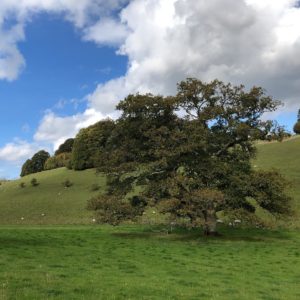Introduction
The National Landscape is not a planning authority, however the National Landscape and the National Landscape Management Plan are material planning matters. The Planning Protocol provides the framework for the National Landscape Partnership to contribute to the evolution of planning policies and the determination of planning applications. This means we provide responses to all relevant policy consultations, at both national and local authority levels.
We normally only comment on major applications that involve 10 or more dwellings or 0.5 hectares or greater of land, and proposals that would have a significant effect on the National Landscape or create an unwelcome precedent.
The Right Tree, Right Place
Tree planting is being widely promoted as a means of capturing carbon – carbon sequestration – and there is a lot more to it than just putting any young tree into the ground somewhere.

In the sensitive landscapes of the Areas of Outstanding Natural Beauty and National Parks it is crucial that landscape character is taken into account when considering tree planting, or any other activity to lock up carbon.
This National Landscape has experienced the unintended adverse impacts of other, earlier, well intended initiatives to increase hedge planting for wildlife. Hedges are not typical of the open downlands of this National Landscape.
Extensive roadside planting of hedges over the past couple of decades means that some roads (eg B3081, B3078) have now become green tunnels, and the views that drivers and passengers used to enjoy across the open and expansive downlands are blocked by hedges that have little habitat value as they have not been laid or planted thick enough.

Selecting the right places for trees so that they not only lock up carbon but become an aesthetic and wildlife feature means relating to the National Landscape’s Landscape Character Assessments. The next step is actually choosing the right species of tree for the particular location and that, of course, should take into account the soil type, aspect, and the adjoining habitats. Of course, one thing to avoid is planting trees on other rare or sensitive habitats.
In order to take this forward with positive guidance the Cranborne Chase National Landscape has commissioned Fiona Fyfe, an experienced landscape architect, to prepare a ‘Right Tree in the Right Place’ statement for this National Landscape found at the top of this page and on our planning publications page. Fiona has been doing similar work in Devon and so is very much up to speed on the issue. She previously helped us with our Guidance on Landscape in Neighbourhood Plans, one of our suite of guidance booklets for not just the communities of this National Landscape but also for agents, developers, and our planning authority colleagues.
Please sign up to our newsletter for updates on this and other projects.
The Planning Protocol
 This Protocol sets out how the National Landscape Partnership and local authorities will consider planning matters affecting the National Landscape. The document contains the October 2005 document as well as the September 2006 Review and Refinement document.
This Protocol sets out how the National Landscape Partnership and local authorities will consider planning matters affecting the National Landscape. The document contains the October 2005 document as well as the September 2006 Review and Refinement document.
As it is not a planning authority the National Landscape is unable to intervene on small applications, and individual planning enquiries should be directed to the relevant local planning authority in the first instance.
The National Landscape team will, of course, always try to provide advice and information where needed. With that in mind, the National Landscape can provide some basic pre-application advice on development proposals free. However, larger, more sensitive, or more complex development schemes may need greater input and so a supplementary advice system is available.
Planning Seminars
The National Landscape holds an annual Planning and Transportation Seminar. This major event provides a valuable forum for highlighting and learning about important issues in the National Landscape which can only be addressed by bringing together a cross section of agencies, interested parties and local communities.
Details of any new seminars will be provided on our news pages.
